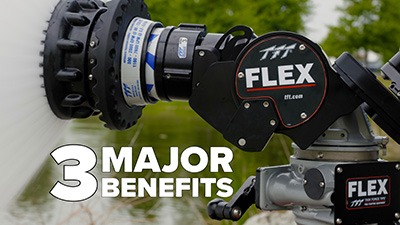Three Benefits of the Flex Masterstream Monitor
Low friction loss, versatile travel limits, and a stationary base make Flex best in class for your firefighting operations
If you’re looking at the Flex Monitor, you’re probably checking out different features to see if it meets your needs. Here are three of our favorites that can make it a top-notch option as your fixed monitor.
Low Friction Loss
The waterway design is based off of the Blitzfire waterway and has been proven over years of use. This waterway uses a series of segments to limit turns and create a cleaner water path in the monitor. With Flex, you can see friction loss as low as:
-
3 PSI at 1250 GPM (4750 LPM)
-
4 PSI at 1500 GPM (5700 LPM)
-
8 PSI at 2000 GPM (7600 LPM)
How do the segments seal?
 |
|
This is a fair question that we’ve seen a few times now. Each segment has an individual sealing surface that has been proven reliable with our Blitzfire Portable Monitors.
Stationary Base
 |
|
See the stationary base demonstrated in this video! |
One feature that is a huge benefit to the monitor operator is the Flex’s stationary base.
When the operator needs to move the horizontal travel of the monitor, the control mechanism stays in one position. This eliminates the operator having to move in line with the monitor as it travels.
For example, when you’re on a platform, you don’t need to reach your hand outside the bucket to continue control. Instead, you can use the full range of travel for the monitor with that control mechanism from one location inside the platform.
Versatile Vertical and Horizontal Travel Limits
 |
|
Wondering about those travel limits? Chris talks through them here. |
Travel limits for Flex will vary depending on what type of apparatus the monitor is configured for and the monitor control method.
RC Flex monitors will have different factory settings based on what you choose.
For aerial operations, the Flex can travel back to a –30-degree angle to accommodate a store front blitz.
For platforms, travel is limited to a lower point, so the nozzle doesn’t come back and hit the bucket.
On both aerial and platform apparatus, the horizontal travel will be factory set to 180-degrees so that the nozzle doesn’t come around and hit the platform or ladder rungs.
Manual versions have a few differences.
On a stationary monitor or pumper monitor, you can have a full 360-degrees of horizontal travel.
If you choose a tiller bar on a platform it will be factory set at 180-degrees to avoid hitting the bucket.
Regardless of which Flex version you get, added hard stops can always be installed on horizontal and vertical travel in the future.
